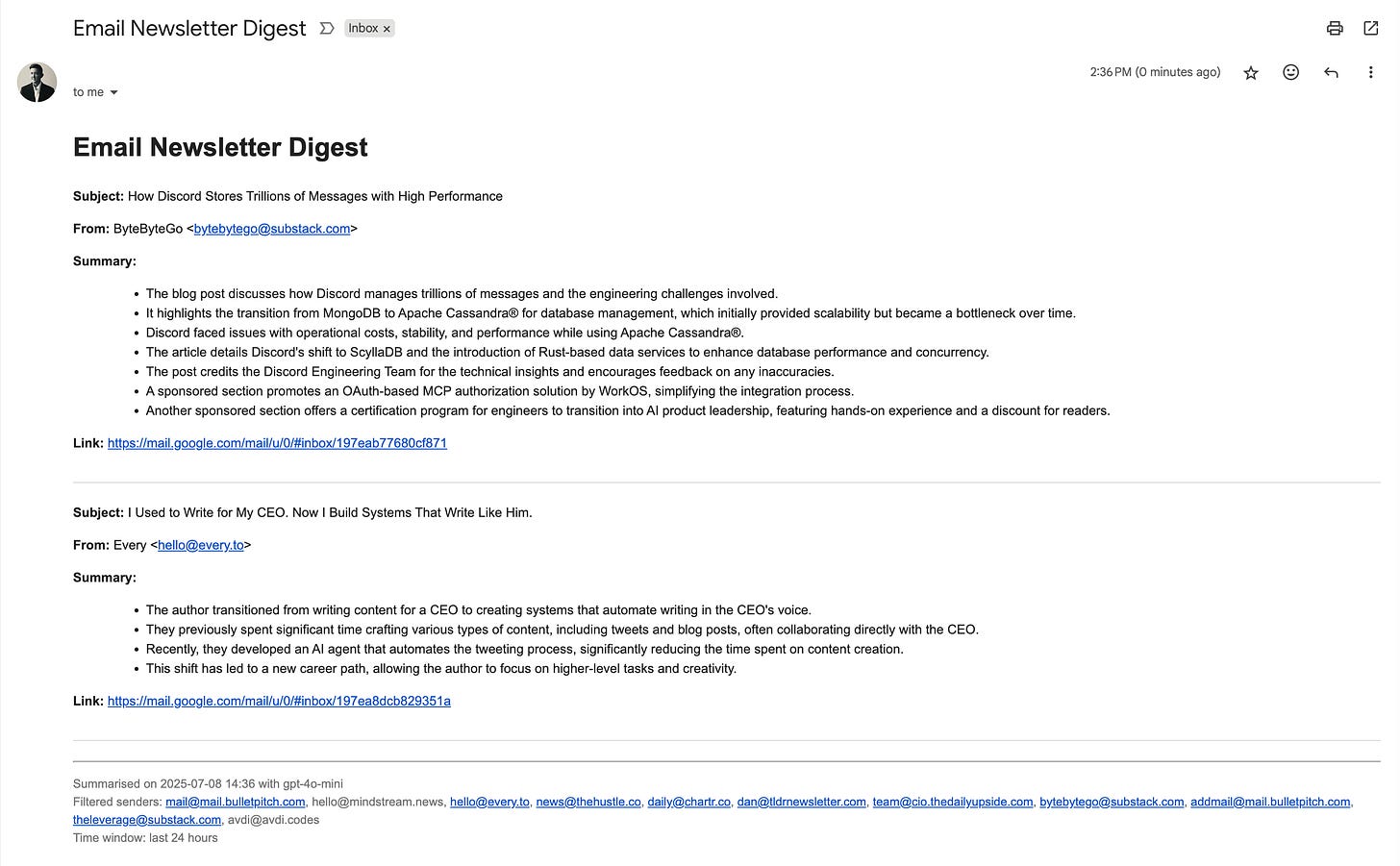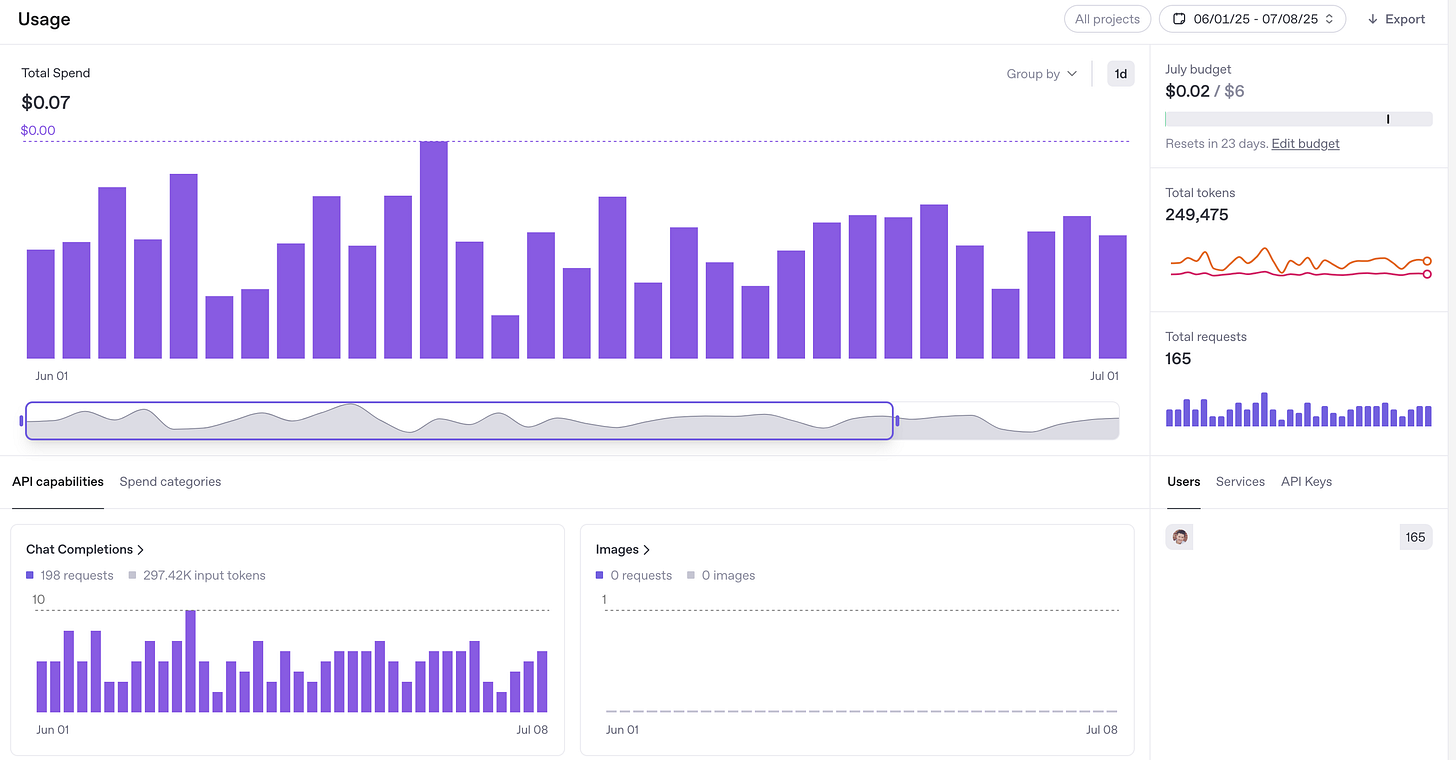How a 7¢ LLM Experiment Rescued My Inbox
A powerful example of how people can level up with LLMs using pocket change
I used to wake up with unread dread, my inbox overflowing with a hundred-something emails and that relentless red Gmail badge. I’d become a digital hoarder—subscribing to every shiny newsletter in the name of “staying sharp” and feeding my chronically curious brain. Between work, side projects, parenting, and life, it was clear my inbox was not going to fix itself.
I didn’t have much luck with email tools. Most couldn’t cut through the noise or were pricey. Gemini’s built-in summaries were weak and required hands-on refinement. I needed something sharper, like an email equivalent of Geoffrey from The Fresh Prince of Bel-Air, an assistant who would do much more than summarize.
So, in true 2025 fashion, I asked ChatGPT for help. An hour later, the problem was solved.
An Email Assistant is Born
Here’s how it works:
Google Apps Script scans unread emails from my curated sender list
Sends content to GPT‑4o‑mini (strong performance at low cost)
Returns clean bulleted summaries, tailored insights, subtle market signs to watch out for—no fluff
Sends a polished digest to my inbox twice daily
Here’s the structure for each summarized email:
Subject: [Email Subject Here]
From: [Sender Name or Address]
Summary:
Insight 1 – Quick, key detail
Insight 2 – What matters most
Insight 3 – Implication or takeaway
Watch Outs:
Potential risk or trend – What to flag
Interesting connection – A signal worth noticing
Link: [Clickable link to open the thread]
Since using my humble email assistant, I begin each day with a couple of emails—usually the important ones, such as school notices or bank alerts—that no longer get buried in my inbox.
Do I miss the polished graphics and immersive layouts? Yes, that is part of the tradeoff. But I don’t miss the scrolling, the weight of dread, or the anxiety of FOMO.
Yep, it’s 7¢
That’s seven cents over thirty-seven days or about the cost of a US postage stamp for a year’s worth of email wrangling. Even a piggy bank could handle that.
Here’s why it’s so cheap — Model selection matters:
GPT‑4o‑mini was chosen for best cost‑performance, priced at $0.15 per million input tokens and $0.60 per million output tokens.
It gets better: OpenAI’s prompt caching automatically “remembers” the part of my request that remains the same, such as the summary instructions I always use. That means most of my input tokens get billed at the discounted $0.075/M rate instead of $0.15/M, cutting costs without extra work.
Let’s break it down:
297K input tokens across 198 calls
~200K cached input → negligible cost
~97K fresh input → ~$0.015
~40K summary output → ~$0.055
Total ≈ $0.07
What started as a way to escape unread dread has become a reminder that thoughtful applications of AI can support us in meaningful ways, helping us reclaim focus, skip the clutter, and stay tuned into what matters. That’s how AI helps humanity, by giving us back space to be human.
New Era: Builders, Not Buyers
We may be entering a new era where everyday technologists stop asking “Which subscription do I buy?” and start asking “What can I build next?” Tiny, composable AI tools—scripts, snippets, agents—replace the need for yet another $20‑a‑month app. You design, you own, you iterate. That is a different kind of economy, and arguably a different kind of internet.
Build Your Email Assistant
If you’re interested in building your email assistant, check out my GitHub for the full script and step-by-step guide. Also, feel free to reach out if you’d like to dig in more.





"New Era: Builders, Not Buyers" - A possible near-future: we all have Star Trek replicators for software ("Make me a TODO app!").
I'm excited to see how this changes UX when your UX can dynamically create new UX.
I also wonder if this makes software much more disposable as a medium. Why would you maintain simple things when you can re-gen? Maybe you're maintaining/refining a prompt?
This all feels like a tourqued-out version of meta-programming.